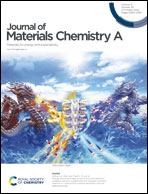Restraining lattice oxygen of Cu2O by enhanced Cu–O hybridization for selective and stable production of ethylene with CO2 electroreduction†
Abstract
The development of highly selective and efficient catalysts for the electrochemical reduction of CO2 (CO2RR) to value-added chemical products is a promising pathway towards zero emissions and carbon neutrality. Cu2O catalyst has received substantial attention due to its distinct capabilities of enhancing the C–C coupling during the CO2RR, while it still suffers from fast deactivation and poor selectivity. Herein, we design a simple yet efficient strategy to successfully stabilize the active Cu+ species at highly applied reducing potential via incorporating boron (B) into the Cu2O lattice. Oxygen temperature-programmed desorption (O2-TPD) and theoretical calculations confirm that the B-doping effectively restrains the lattice oxygen of Cu2O, which consequently strengthens the Cu–O bonds. The resultant B-doped Cu2O substantially suppresses the reduction of Cu+ species under long-term electrolysis, achieving an efficient production of CO2-to-C2H4 for at least 8 h at −1.2 V. Importantly, we used in situ and ex-situ spectroscopic characterization studies to trace the evolution of copper valence during the CO2RR, thus identifying the role of the restrained oxygen lattice in stabilizing the active Cu+ centers of the Cu2O catalyst. This work provides a deep understanding of the Cu+ dependent catalytic performance of the Cu2O catalyst, and paves a novel way to design high-efficiency electrocatalysts for the CO2RR.



 Please wait while we load your content...
Please wait while we load your content...